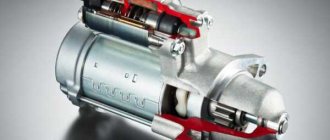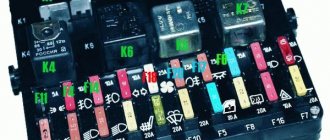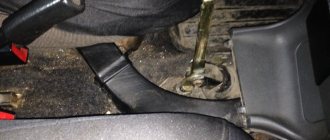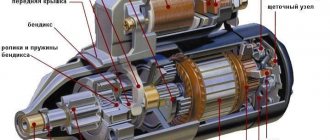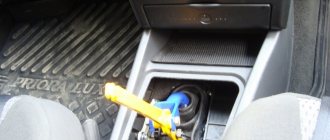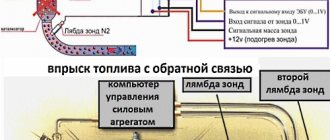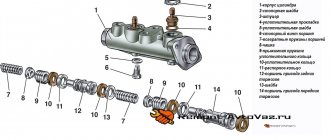The starter bendix (or overrunning clutch) is a part of a car engine that transmits rotation from the starter to the crankshaft. Bendix is built quite reliably. If it fails, it is mainly due to the natural wear and tear of metal parts. To understand the possible causes of failure, we will analyze in detail how it is designed and works, as well as how to change the bendix.
How does bendix work?
It consists of:
- inner race with gear;
- housings with an outer ring;
- rollers with springs;
- sealing washer;
- retaining ring.
The gear may have 9 teeth, 10 or 11 teeth. There is a more complex geared bendix.
The outer (driving) race of the bendix is tightly fixed to the armature and transmits rotation from it to the inner (driven) race. The clutch occurs due to spring-loaded rollers. The gear on the driven cage engages the crankshaft flywheel and spins it, the fuel ignites in the combustion chambers, and the car starts. To do this, the flywheel and crankshaft must rotate at a frequency of at least 100 rpm. per minute Since the Bendix gear is 10 times smaller than the flywheel, it needs to spin 10 times faster, that is, at 1000 rpm. per minute When the engine starts, it starts running at 1000 rpm. per minute It turns out that now the flywheel should turn the starter armature, and also 10 times faster (10,000 rpm). But Bendix prevents this. When the speed of rotation of the crankshaft exceeds the number of revolutions of the electric motor, the springs stop putting pressure on the rollers, the clutch between the inner and outer races disappears, they begin to rotate at different speeds, this saves the starter from jamming.
Removing the starter from under the hood
Before removing the starter
An inspection hole will be needed to remove the starter from under the hood, and then diagnose it outside the car. Anyone who does this for the first time will spend relatively a lot of time, so before starting dismantling, you can try to clean the starter contacts, which may have oxidized during operation, make sure that they are securely fastened, and perhaps also replace the power wires.
You need to check the entire electrical circuit, so you should make sure in advance that the problem does not lie in the battery. If these simple measures do not resolve the problem, the device must be removed.
If you do not know where the starter is located in your car, you can focus on the sound under the hood that appears when you turn the key - for this you will need the help of a second person who will be sitting in the car.
Extraction process
First of all, you need to disconnect the device from the battery - remove the terminals and conductive cables from the solenoid relay. After this, the fastening bolts are unscrewed, usually there are 2 or 3 of them - for this you will need a hinged extension.
It was already mentioned above that an inspection hole is necessary for this work, since sometimes in order to dismantle the starter it will be necessary to remove the components and mechanisms located on the way to it, in most cases the engine compartment protection trim.
How to find out if the starter bendix is working properly
You can check this in two ways: by first removing it from the car or by ear. The second method is simpler. If, when starting the engine, the starter rotates, but the engine does not start, and a metallic clanging sound is clearly heard, then the starter bendix is faulty.
If you still had to remove the starter, you need to carefully inspect the overrunning clutch. Signs of breakdown that you should pay attention to:
- does it rotate, as intended, only in one direction;
- whether the teeth of the gear are worn out;
- does the bendix sit tightly on the armature splines;
- is there any wear on the drive holder and rollers;
- Have the springs lost their elasticity?
You can change individual clutch parts, but usually the Bendix units wear out at the same time. Auto service technicians advise not to save money and buy a new device.
Possible causes of failure
If the gear rotates in both directions, this is a malfunction.
There may be three reasons:
- deterioration of rollers due to friction, sometimes their surface can even take on the appearance of a polyhedron rather than a cylinder;
- grinding down the surfaces of the grooves in which the rollers are located;
- broken or weakened springs.
Rollers with grooves in the form of flat edges.
Springs and rollers can be replaced by selecting suitable ones. Even 15-20 years ago, Bendixes were often repaired, returning them to functionality.
Now almost all models are available in stores, others can be ordered.
The coupling is inexpensive and it is not economically reasonable to repair it - restoration work will cost more than buying a new part.
The second most common failure is wear of the gear teeth . It can be replaced, but it is easier and cheaper to replace the entire bendix.
How to remove bendix from starter
We unscrew the starter; if there is no gearbox, then carefully knock the washer off the armature and remove the retaining ring. Remove the bendix from the axle. We replace it with a new one, which we install in the reverse order. The most difficult part is installing the washer and retaining ring. For this, craftsmen use clamps, special wrenches, and sliding pliers. Replacing the bendix on the starter requires some practice.
Sometimes a malfunction occurs due to dirt getting into the mechanism and there is no need to disassemble the starter; you can try to revive it. To do this, the anchor with the overrunning clutch is dipped in a container of gasoline for 5–7 hours and the gear is periodically turned. Afterwards, the starter needs to be dried thoroughly and tested. If it does not work, then disassembling the unit cannot be avoided.
How to check the overrunning clutch
If you are not in a hurry to change the Bendix, then it is worth testing it. To do this, clamp the body of the overrunning clutch, already removed from the starter, through a soft gasket (for example, a rag) in a vice to prevent damage. Try scrolling the bendix left and right. It should only rotate in one direction, because when you try to rotate it, the working part will lock. If the overrunning clutch turns, this means that it will not engage with the teeth and the starter will “thresh” idle. You can determine the serviceability of the gear visually: you will see the “eaten” teeth immediately. But if the starter is stuck, then you can understand this only by disassembling it. In this case, all the “internals”, including the gearbox, must be cleaned of dirt, dried grease and washed with clean gasoline. Next you will have to decide whether the bendix can be repaired or whether you will need to purchase a new one.
Checking the performance of Bendix directly on the car
This can be done without removing the starter. To do this, turn on any speed, press the brake pedal and turn on the starter. If the car just jerks forward, then everything is fine - most likely, your overrunning clutch is working. The sound of the armature rotating indicates that the bendix is slipping, which needs to be repaired or replaced with a new one.
What do car mechanics advise?
Before removing the starter and changing the bendix, make sure that the battery is charged. There are funny cases when the problem was not in the overrunning clutch, but only in a discharged battery.
Don’t skimp on small things - be sure to install only a new washer and retaining ring.
When going to the store, don’t be lazy to take your old Bendix with you. Sometimes, at first glance, absolutely identical couplings differ in minor details.
Before installing the bendix, thoroughly rinse and lubricate all rotating parts and armature splines.
When disassembling the starter, write down the sequence of actions. This will make it easier to assemble the unit.
Before installing the starter, check it. To do this, take two wires that are used to start cars in cold weather. Connect the “minus” to the body, the “plus” to the contact on the solenoid relay. If the starter is working properly, a characteristic click will be heard and the overrunning clutch will move forward.
Removing the starter from the car
On passenger cars, you can remove the starter in just a few minutes. To work, you will need a minimum set of keys - 10 and 13. Moreover, the VAZ-2109 starter bendix is replaced in the same way as on earlier models. Remember that you are repairing electrical equipment. Therefore, it is imperative to disconnect the battery. A large cross-section wire is laid from the positive terminal to the starter; it is not protected by any devices, so in the event of a short circuit, the risk of a fire is very high.
After disconnecting the battery, disconnect the two wires from the solenoid relay. The thin one is necessary to supply voltage to the relay coil; it appears on it only when the key is turned to the extreme position. A thick cable is required to power the starter windings. Using a 13mm wrench, unscrew the three nuts that secure the housing to the car’s clutch block. Sometimes this action is not very convenient to carry out, for example, on VAZs of the classic series. With them, the lowest nut is unscrewed from the bottom of the car, and even using heads with cardan shafts.
Let's sum it up
Bendix is an important starter part. It transmits rotation from it to the engine flywheel. If the support clutch fails, the car will not start. You can determine the breakdown by ear. If the starter turns, but the gear starts to slip and does not rotate the engine, then it is the overrunning clutch that has failed. You can remove and repair it yourself. But if wear appears on the surface of the rollers, outer race or gear, then it is better to install a new bendix.
If you have any questions, leave them in the comments below the article. We or our visitors will be happy to answer them
Device
Bendix consists of several elements that cannot be divided by degree of importance, because they all equally affect the operation of the device. The base is a metal sleeve, inside of which there are spiral-shaped slots for connection with the rotor. They allow the Bendix to move freely along the axis under the action of the retractor relay. To return to its original position, the latter has a spring. Some Bendix models also have return springs in their design. An overrunning clutch is an element that affects the performance of the mechanism. It allows the Bendix to transmit rotation in one direction. A gear is attached to the clutch, which is necessary for communication with the flywheel ring - its tooth pitch is exactly the same. A plastic or metal plug allows you to connect the solenoid relay and the Bendix housing.
Do-it-yourself Bendix repair (video)
What else is worth reading
Hall sensor in distributor
Starter operating principle
Windshield replacement
Spar
Charging a car battery without removing it
Price issue
Finally, it’s worth adding that Bendix is an inexpensive spare part. For example, a Bendix VAZ 2101 (as well as other “classic” VAZs) costs about $5...6, catalog number is DR001C3. And the price of Bendix (no. 1006209923) for VAZ 2108-2110 cars is $12...15. The cost of Bendix for FORD cars of the Focus, Fiesta and Fusion brands is about 10...11 $. (cat. no. 1006209804). For TOYOTA Avensis and Corolla cars Bendix 1006209695 - $9...12.
Thus, repairs are often impractical for Bendix. It's easier to buy a new one and simply replace it. Moreover, when repairing individual parts, there is a high probability of rapid failure of others.
- Do-it-yourself brake caliper rebuild for Mitsubishi Lancer 9 Repair of Lancer 9 calipers
- Do-it-yourself repair of the lower arm of the front suspension of a VAZ
- How to clean a stove radiator without removing it? Cleaning, washing
- DIY muffler repair
Possible faults
Possible starter malfunctions arise, as a rule, due to violation of its operating conditions.
Signs of breakdowns and diagnostics
Symptoms of the most common starter problems:
- suspicious noise or crackling noise when turning the ignition key;
- the engine stalls without the electric motor operating;
- inability to start the internal combustion engine;
- “sneeze” of the starter mechanism without engaging the flywheel.
Most often, the starting device breaks down due to an open electrical circuit, so you should check:
- battery charge level;
- wiring for damage;
- fastening terminals;
- ignition keyhole.
If there are no problems with the above, then the next step is to check the traction relay. This element can be diagnosed without removing the starter, since the operation of the electric motor depends on it. If, when you close the contacts on the relay with a flat-head screwdriver, the electric motor starts, then the cause of the breakdown lies precisely in this part.
Types of faults
There are two types of starter malfunctions - mechanical and electrical.
Electrical problems requiring qualified assistance:
- periodic closure of the armature winding;
- breakage of the solenoid relay and stator;
- breakage of brushes and contact plates;
- core wear and lack of contact in the electric motor.
Starter mechanical faults:
- locking the switching drive on the flywheel crown;
- deformation of gear teeth;
- damage to bearings and bendix;
- burnt surface of "nickels".
Causes of problems
The most common causes of malfunctions:
- If the starter begins to “buzz” characteristically and idles, it means that the overrunning clutch is not connected, and the mechanism operates without the gear engaging the shaft. The problem can be resolved by washing the Bendix in a special cleaning solution or gasoline. It is recommended to place the part in a container with liquid, let it sit for an hour and a half, and then move the drive a couple of times to clean the mechanism.
- If the car does not start, the reason may lie in the lack of power supply. If the circuit is working properly and there is current, it is necessary to check the relay, perhaps the reason lies there. You should thoroughly clean the element from dust, carefully examine the contacts again, assemble and replace the components. If the problem persists, most likely the winding is shorted, and only replacing the part will help.
The video (author - Alexander Anikin) shows in detail why you need to clean the starter and the main stages of this process.

